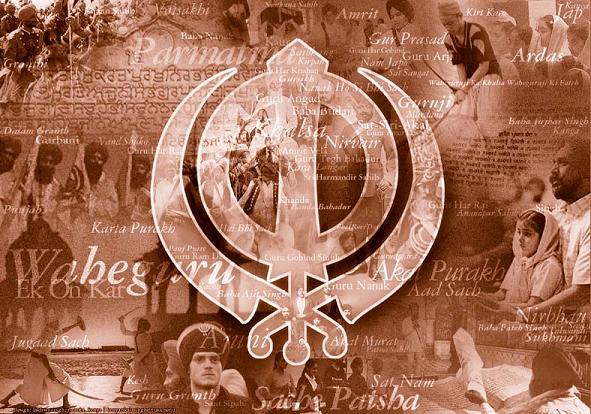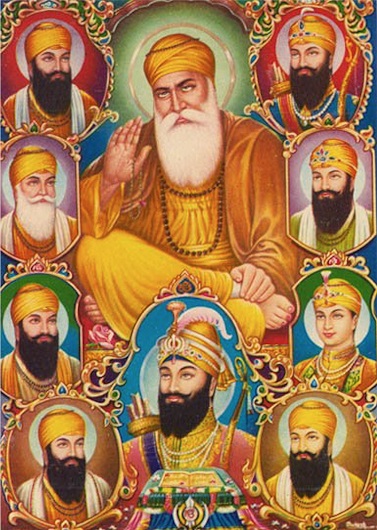A Celebration & Hope
Sikh Sacred Music
Christians and Hindus are way ahead of us.
Christians have boys' choral ensembles, mixed choirs, women gospel singers, and accomplished instrumentalists. Church history even speaks of the castrati gospel singers that we wouldn't want.
Much of Indian classical music, too, owes its development to early Hindu worship - a close association that is no longer apparent.
Male cantors have dominated Judaism and its services.
On the other hand, Muslims never allowed or mixed music in their religion until the emergence of Sufis.
Much of Western classical music - instrumental and vocal - owes its development to the patronage of the Church. Mostly men but some excellent women's voices as well have enriched our lives by religious music. The American Black Christian community has produced the most scintillating and electrifying women gospel singers. Here we are thinking of Mahalia Jackson, Shirley Murdock, Shirley Caesar and Vickie Winans, among others.
In the realm of sacred music Sikhism is highly unusual, if not unique.
Its entire scripture, the Guru Granth, with a few minor exceptions, is set to the language and idiom of classical Indian musicology. Sikhism's Guru-Founders were superb poets and musicians and recognized that music can transcend words. One would think that the grammar and technology of music are only vehicles to carry the meaning of the words and their message, but when the Gurus married divine poetry to heavenly music they created a whole that remains greater than the sum of the parts.
Naturally then, central to a Sikh service is the Guru Granth and the celebration revolves around keertan - the singing of the liturgy. History tells us even reputable non-Sikh Indian singers would often visit gurdwaras, not because of any great love for Sikhi, but to learn and pick some pointers on esoteric intricacies of classical Sikh vocal music.
But Sikhs are not immune to rash and immature decisions: one is the illogical ban on women performing keertan in the Harmandar Sahib. The administrative hierarchy made a one-time exception when in the 1970's Western women converts to Sikhism were allowed to sing at the Harmandar ... but never again.
This flicker of common sense died; the jathedars responded to the inevitable protest by promising hearings and quick action in the matter. But time is a very different animal in the Indian socio-cultural reality and almost 40 years later we still await the return of sense and reason. It remains an ill-considered ban that continues to defy common-sense.
Yet, some of us have always been seeking out women who were exponents of keertan.
There have always been individual women, like Surinder Kaur or Jaspreet Kaur Narula, who also sang hymns from the Guru Granth but not all that many and not with the same single-minded commitment to either gurbani or to the cause of spanning the gender divide.
Then a couple of years ago we heard of this Ludhiana-based group of women who were singing gurbani in raags. Their recordings were not easy to find and they were not on the radar for most of us. But to find one of their recordings became a pleasure - somewhat like a successful treasure hunt.
Now these women - the Gurmat Gian Group of the Gurmat Gian Missionary College - have produced a set of six CD's with hymns from the Guru Granth in each of the 31 raags; each hymn rendered in the shudh (pure) raag, as recommended in the Guru Granth.
We admire their attitude that they summarize thus: "To sing gurbani in raag is not the same thing as to sing raag in gurbaani."
We agree entirely.
Gurbani affirms the importance of meditative singing to attain a state of spiritual bliss:
"Heaven is where Your praises are sung"
(tahan baikunt jeh keertan tera, GGS:749)
Listening to these renderings by this gifted group is truly a spiritual experience. Their highlighting of keertan in raags successfully establishes classical keertan as a religio-cultural heritage of both Sikh women and men. This is a most notable achievement.
The Shabad sung to melodious classical notes led by Gurpreet Kaur reminds the listener of the line in Anand Sahib that speaks of angelic, musical families coming together to sing the Guru's Word" (raag ratan parwaar parian sabad gaavan aaiyan, GGS:917).
The Divine Word is experienced as musical "dhun" or celestial melody, whereby the human soul comprehends the incomprehensible. The "Akath Kahani" (The 'Unutterable Story'), becomes more meaningful. The mind is attuned to God through celestial music, and in meditation, by the Guru's grace, the indescribable (ultimate Reality) comprehended. (dhun meh dhian dhian meh jaanya gurmukh akath kahani, GGS:879)
What one of us ('G.S.') wrote earlier about keertan by this group remains equally relevant today:
"The spirituality and depth of Ardaas is felt in shabads like "hey sansaar taap harnay" (GGS:1358), that, like so many other shabads by the Group, brings out the musical miracle of four angelic voices in perfect harmony, individual renditions and changes in taal (beat) between jhap (10 beats), teentaal (16 beats) and ektaal (yakka of 12 beats) - all rendered effortlessly .. And so on, each and every shabad is the Guru's Message delivered directly to the keertan rassia's inner being."
Heaven is where Your praises are sung.
Raags are mood inducing melodies which also relate to times of the day and seasons. Productions like "Raag Ratan" stressing the classical raag in which each shabad appears in the Guru Granth, enhance the impact of experience and understanding. The Guru's Word - gurbani - is in verse. The Word was delivered by the Sikh Gurus, as received from God: "As I receive the Word of the Lord; so do I express it, O Lalo", says Guru Nanak [GGS:722].
The received Word was in meditative verse. Gurbani keertan is an "experience" of the Word. The realization comes with repeated experience through keertan.
Dr. Balbinder Singh Bhogal, a scholar of Sikhi, reminds us:
"Indeed, part of the lure of the poetic form is that it eludes total comprehension and is enriched by ever new interpretations. The poem does not provide an answer to life's mysteries, but reveals its wonders. The poem by its very form is not limited to a singular meaning, so it does not offer an answer with the confidence of an ego-centric bark. Instead, it entices the ego to unravel its mystery, and in the process unravels itself. The poetic structure is inherently contemplative and unsettling - it refuses to be tamed into singular plain speech of prose philosophy."
Therefore, the musical aspect is stressed in Guru Granth Sahib and the name of the raag specified for each composition. The melody creates the environment and mental state for focussed reception of the Word. Singing the praises of the Creator in sangat (holy congregation) then takes precedence above all else. One is able to sing with and listen to others, and by sharing that experience, is able to contemplate and realize the Word within oneself. By repetition of this personal and congregational experience, the ego-centric focus is replaced by humility and wondrous love and awe for the Creator.
This altered attitude (by the Guru's Grace) would then reflect in the behaviour and daily life of a Sikh, which stresses humility and meditation on the Creator in the life of a householder in the service of the Creator and creation. The Ultimate Reality cannot be captured in words alone.
Raags induce moods corresponding to time-divisions of the day; to seasons or occasions, etc. There are many rhythms, beats and rhymes. These reflect the wide spectrum of classical and popular musical traditions of the sub-continent and contiguous areas. With minor exceptions, gurbani is meant to be sung for maximum impact of its intrinsic message.
Gurmat Gian Group - "Raag Ratan" experience
Starting with Sri Raag - the first of the 31 raags in the Guru Granth - Gurpreet Kaur, the composer and singer, accompanied by her daughter Keerat Kaur, lead the Keertan "rassia" (meditative listener) on a spiritual journey. Music accompaniment is under the direction of Sonu Khanna, with Sandeep Singh on Dilruba, the Guiness world-record tabla player Paramjot Singh, and Jaganpreet Singh on tabla and pakhawaj.
Introduction to the shabad by Gurmat Gian Missionary College Principal, Rana Inderjit Singh, is in concise and simple Punjabi.
The pattern for singing shabads is similar. However, traditional delivery of raag, starting with prolonged alaap and very slow beat, followed by increase in tempo to a climactic fast beat, is not followed - and that is a blessing for the average ear. Instead, after the introductory raag base (mukh ang) played on dilruba or sung vocally, the listener is held spellbound by intricate vocal variations and taal (beat) changes.
To quote Dr. Manbir Singh,
"One of the features of this collection is that shabads are sung in many uncommon taals like Jhumra, Matta, Rudra, Sool, Panch Savari, Champ Savan, Dhamar, Jai Taal, Araha Char taal, Firodast, along with routine taals."
Indeed, the effortless beat changes (parhtaals) become almost imperceptible. (Being conversant with main taals only, we personally used finger count of beats (matra, taali/khaal, etc) to track taal changes.
The immensely popular Raag Maajh is the vehicle for "sun sun jeeva soe tumaari ..." It is rendered as a duet by Gurpreet Kaur and her daughter Keerat Kaur. The spiritual journey in dhun continues through the raag.
"Har samrath ki sarna" [GGS:987] in raag Maali Gaura is mesmezing in its meditative appeal and raag-taal technical complexity. As Manbir Singh tells us, "Maali Gaura is in Dhamar Taal (14 beats) - Dhamar Shaiylee. Indeed, technically the most challenging; this Shabad took the most time to record ... None of the team had performed this earlier in this taal and shaiylee."
And on full display are Gurpreet Kaur's enviable depth and range in meditative raag-based singing and total command of sur and taal.
Naturally, one tends to tune in on one's own favourites such as Maajh, Malhar, Basant, Kanra, Kalyan, Jaijavanti, Jaitsri, Nutt-Narayan, etc. more often. The increasing dependence on the harmonium and pop rhythms by even notable raagis has possibly been the bane of good keertan in recent years. Hence we take note of the revival of singing with string instruments (taanti saaj) as in "Raag Ratan". Because of the infinite shruti (divisions of the "naad" or notes), a vocalist of Sikh classical tradition has more possibilities of expression since he can play subtle fractions of notes - this option remains extremely limited in Western vocal or instrumental traditions.
Comment on this classical music art collection from a strictly technical aspect is beyond our pale. However, as avid listeners we felt sometimes that the shabad could have been concluded sooner by avoiding some technical tabla fireworks towards the end. As a "gandharab" raagi, Sant Sarwan Singh recommends in his writings on Gurbani Keertan: tabla should enhance the shabad singing and pyrotechnical displays restricted to solo performances.
This minor caveat aside, Paramjot Singh and Jaganpreet Singh have excelled at a most gentle and musical "kinaar" while playing deep sounding pakhawaj ("mridang" type of beats) where needed.
As Gyani Jarnail Singh of Malaysia tells us,
"This is exactly the way ilaahi (divine) gurbani should be sung, in perfect taal, sur ... I congratulate these soul-brides of our Beloved Guru ..."
The women of the Gurmat Gian Group may not be in the same class as maestros like Bhai Samund Singh, Dharam Singh Zakhmi, his brother Shamsher Singh and son Amrik Singh Zakhmi, Avtar Singh; Dillbag Singh - Gulbagh Singh, Baljit Singh (Namdhari), Balbir Singh and Nirmal Singh or Singh Bandhu, and other legendary singers of gurbani, but they are breaking fresh ground. These women are a breath of fresh air.
"Raag Ratan" is truly a historic and, for Sikh women, an exemplary accomplishment by the Gurmat Gian Group. It is a unique gift for listeners of classical gurbani sangeet. It is the first production of its type by Sikh women.
Gurmukh Singh (U.K.) - sewauk2005@yahoo.co.uk
IJ Singh (USA) - ijsingh99@gmail.com


